From the Section Chair

Dear Colleagues,
 Since last August the Information Technology Section
Standing Committee (SC) members have been very active in the preparation of the
next IFLA World Library and Information Conference program in Singapore. We are
grateful to the SC members and guests that attended the last two SC meetings in
Helsinki with whom we defined the relevant topics of our future sessions.
Since last August the Information Technology Section
Standing Committee (SC) members have been very active in the preparation of the
next IFLA World Library and Information Conference program in Singapore. We are
grateful to the SC members and guests that attended the last two SC meetings in
Helsinki with whom we defined the relevant topics of our future sessions.
Many libraries have started opening their bibliographic data and linking it with other datasets. What are the experiences of these libraries in integrating Linked Data from multiple sources and providing access to it through appropriate end user interfaces will be presented and discussed at IFLA pre-conference on “User interaction based on library linked data” on 16 August 2013. We are very thankful to the colleagues of Jurong East Regional Library of Singapore who are helping us in the organization of this event.
During the main IFLA World Library and Information Conference in Singapore we are planning two sessions. One joint session will be organized in cooperation with the Preservation and Conservation Section, Rare Books and Manuscripts Section, and Library and Research Services for Parliaments Section. It will be dedicated to the integration of physical and digital preservation processes in libraries.
Another session organized by the IT Section will deal with innovative and useful open source experiences in libraries from all parts of the world. The decision to address the topic on open source was strongly supported by the members of our section who have recently created the Open Source Working Group. It has been very active in fostering support and promoting open source solutions in libraries.
The call for papers for these events are being published through the IFLA list serve and the IFLA IT section website at http://www.ifla.org/it. We invite you to submit paper proposals.
Our IT Section is also supporting two Special Interest Groups on Semantic Web and RFID which are also preparing very interesting plans for next year. If you are interested to take active part in their sessions, please contact their respective convenors.
For additional information on our activities and plans, please visit our IFLA web-site. There you will find the amended IT Section Strategic Plan for 2012-2013. You can also propose ideas and share with us your opinion about relevant trends and developments on IT in libraries. If you have any question, feel free to ask me or any of the standing committee members of the IT Section listed in this newsletter.
I would like to use this occasion to wish you happy season holidays and a very productive and successful year 2013!
Alenka Kavčič-Čolić
Editorial
 by
Edmund Balnaves,
by
Edmund Balnaves,
IT Section Information Coordinator and Editor
Welcome to the second issue of TILT, and the last for 2012.
Behemoths such as Apple and Google have launched exciting and challenging electronic resources have are changing the library scene. It is tempting to advocate these as the universal one-stop-shop of the future, encompassing research, audio, video and digital resources, and perhaps representing a future that renders unnecessary the library and the librarian. That is not my take: libraries can remain relevant in this emerging new era, but not by fleeing the techology field.
The Internet, as a concept, has been successful not because it is monolithic, but precisely because it acts as an effective glue between a multiple resources. It is flexible and uniquely easy to hook into. The web, on the foundation of a simple protocol (HTTP) provided a framework for easy document sharing. This is the recipe for success for libraries: to build, own, contribute to and participate in a rich collection of inter-connected electronic resources. Librarians understand metadata, and have worked with systematic expression of metadata for many, many years.
While the role of libraries is changing, their essential importance remains. It is, however, vital that libraries introduce their organisations to the new territory of digital libraries and to digital ownership of their own resources. Otherwise they, like their clients, risk becoming digital serfs to the emerging internet barons.
There are several Information Technology movements which present great opportunities for libraries:
- The open source movement and the emergence of stable, robust, digital library systems that can be owned and managed by libraries.
- The open access movement, and the increasing desire for institutions to own and publish their own intellectual output
- Systematic metadata search and harvesting tools to provide aggregation tools and service layers for libraries
The linked data movement, to provide a successor to purely bibliographic data sharing systems to valuable ways of systematically inter-connecting digital libraries (and other web-accessible resources) in semantically meaningful way. These movements, taken together, represent a alternative to the monolithic vision of the web information resource. This is a distributed vision – where quite small and very large collections can be bought together in a semantically meaningful way. It is also one where the library and librarian mediate internal datasets, digital and physical collections and external resources such as supplied by the behemoths to the benefit of their organisation in effective knowledge management, education and entertainment.
Linked data has been emerging at the last few IFLA conferences as a growing force for interconnection and discovery of resources. While libraries have typically previously dealt with “documents” rather than “data”, the data that is “linked” drills down for the traditional publishing unit of a “document” to a lower level: databases and research datasets can be presented as linked datasets. So also can digital libraries as collections of documents. The important thing about linked data is to prise apart and explicitly express the relationships between data items in a systematic way so that data as unitary information sets can be related to other relevant information sets. The Bernes-Lee vision on this was to express these relationships in a using the internet URI naming conventions and the HTTP web framework as a way for massively interlinking data. This vision has been slow materialising, in conjunction with the semantic web. Bernes-Lee’s best allies have been libraries, because the bedrock of a semantic web vision is the sort of authority control and structured metadata that libraries have dealt with over many years.
Linked data featured at a number of sessions at the recent IFLA congress in Helsinki (see www.ifla.org/news/presentations-from-oclc-linked-data-round-table-available ) . The GenNext conference in Dubai recently illustrated the resources emerging from libraries: for instance the Lontar Digital Library project in Indonesia, with its integration of RDF and linked data for its underling collection of digitised books, film,slides, photographic and audio collection of Indonesian resources (http://gennextbrunei.wordpress.com/2012/07/12/the-lontar-digital-library/).
What we see are previously isolated digitised resources being made available through linked data in interesting new ways. Evolving in Europe are the most impressive national and transnational integrated resource collections: Europeana (www.europeana.eu/ ) being just one of them. Europeana represents a massive, multi-lingual, online collection of digitised items from some of the greatest libraries, archives and museums in Europe (http://www.europeana.eu/portal/)
The Euorpeana Linked Open Data (LOD) project contains metadata on well over 20 million digital resources. Such a rich resource has not materialised by itself: it has taken solid work by the major library institutions. Significant in this is the Data Exchange Agreement (DEA) that provides a consistent framework for delivery of the lined data. In Australia and regionally there is lots of potential in this area, and many exciting projects that are either nascent or underway (http://pro.europeana.eu/linked-open-data). Many institutions in Australia, especially governmental agencies, have rich research and report resources collected over time, including data sets. These can be made available. They can be linked together. The library should be central in this process because libraries understand metadata and are proven custodians over time of valuable knowledge resources. Trove in Australia has illustrated how multiple resources can be pulled together in great ways.
The technological platforms to build and make available these resources are now available, and not just to the large national institutions. Libraries have been early adopters of open source and open access. Indeed, open source has transformed the library technology marketplace. Open source has not eliminated commercial library software: if anything it has invigorated the information technology scene by presenting a challenge to what was otherwise a static library technology marketplace: it has raised the bar in expectation of what commercial systems should deliver, and has also raised the bar on expectations for open interchange of data.
The internet has prised open the possibilities of libraries, but at a cost to the library profession: the nature of the librarian, and the library is changing rapidly. This represents a challenge of course, and change is upon us: right now. Librarians need to be engaged with their professional association precisely as a way gaining agency over the new and changing ways the library can operate. Libraries should be in the forefront of promoting organisation and regional linked data resources and the opening of valuable institutional data sets. Digital libraries can become the storehouses of local knowledge. Linked data is the systematic expression of relationships that are there already, just perhaps not well expressed. These natural relationships are profoundly expressed by Donne: “No man is an island, Entire of itself. Each is a piece of the continent, A part of the main.” (see the Library of Congress linked data record for John Donne at http://id.loc.gov/authorities/names/n84121411.html).
Internationally the IFLA congress represents a great opportunity to take the measure of new developments affecting libraries. The best way to get the most out of such conference is to not only attend but also be involved. While IFLA is a large, even daunting, event, it is also an exciting one. I have been going to IFLA for 6 years now, as part of the IFLA IT Section, and it is quite apparent that IT affects every part of the library operation. Linked data is one of the topics you will certainly hear more about over the next few years.
Lost in the Stacks -Location Service for Libraries
 By:Petteri Kivimäki,
By:Petteri Kivimäki,
The National Library of Finland
Searching for books can be a difficult task for a novice library user, which can cause problems for them in everyday basis especially in large libraries. Using a library's online search is the easy part, but the problems usually arise when the material needs to be located in a library. The most common reason for this is that users do not know how to interpret call numbers, which are often based on the classification system and collections codes used in libraries.
The Location Service is software as a service (SaaS) wayfinding application developed and maintained by The National Library of Finland, which is targeted for all libraries. It is a web-based service, which provides additional information and map-based guidance to books and collections by showing their location on a map, and it can be integrated with any library management system or discovery tool, as the integration is done by adding a link to the Location Service in a library's search interface.
The main purpose of the application is to help library users to locate publications in a library by showing their location on a map. In addition to the map-based guidance, the Location Service also provides other information about the location, which should help the user to navigate through stacks of books. Elaborate collection and classification codes often used in the call number are presented in a form which is understandable to any library user. Displaying subject matters or images related to the location are also possible, and the use of images is recommended as it creates a link between the virtual and real word.
The integration is done by adding a hyperlink to the query results provided
by a library's search interface. 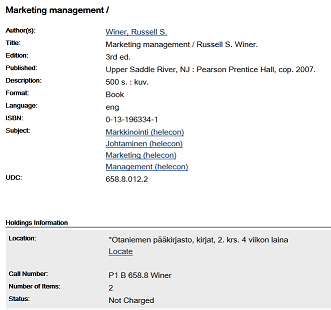 When a user clicks
the link, the Location Service shows the location of the publication in a new
window or tab. The call number of the publication and the language of the UI
are passed as parameters, so the application knows which location a user is
requesting and in which language the results page should be shown. The
information related to the locations is stored in the application's own
database, and the service is independent of all other systems apart from the
hyperlink on a library's search interface. The software and database are stored
on a server hosted by the National Library of Finland.
When a user clicks
the link, the Location Service shows the location of the publication in a new
window or tab. The call number of the publication and the language of the UI
are passed as parameters, so the application knows which location a user is
requesting and in which language the results page should be shown. The
information related to the locations is stored in the application's own
database, and the service is independent of all other systems apart from the
hyperlink on a library's search interface. The software and database are stored
on a server hosted by the National Library of Finland.
The Location Service has two user interfaces: One for customers and one for
library staff for managing the information related to the locations of
publications. The UI for customers is fully customizable by libraries, and the
customization is done via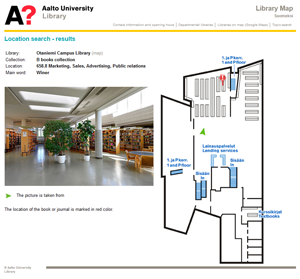 template files by using the
following techniques: HTML, CSS, and Javascript/jQuery. The application
supports multiple languages, and libraries have a full control of the languages
which they want to support in their environment. All the information related to
the locations can be managed via the administrator’s interface, which does
not require any technical skills to use.
template files by using the
following techniques: HTML, CSS, and Javascript/jQuery. The application
supports multiple languages, and libraries have a full control of the languages
which they want to support in their environment. All the information related to
the locations can be managed via the administrator’s interface, which does
not require any technical skills to use.
In addition to public and administrator’s interfaces, there is also a third interface, which makes it possible to retrieve XML data over HTTP. This feature allows for third party applications to utilize the information stored on the Location Service and present it in external websites or services. Nevertheless, libraries control the access to the interface, so it is not accessible to everyone by default.
The implementation of the Location Service is quite effortless for libraries
since it does not require installing any software on a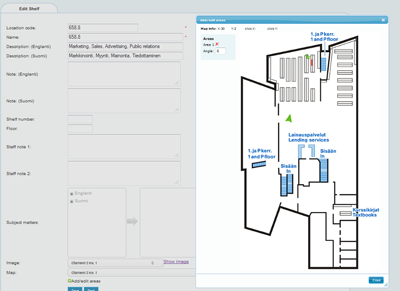 desktop system or interrupting any existing work
processes. Libraries only need to add the information related to their
collections to the application and to customize the layout of their public
interface. The amount of time needed for adding the necessary information
depends on the size of the library and the level of accuracy in which the
collections are added. Libraries do not have to add all their collections to
the Location Service at once, since it is able to display locations on library,
collection, and shelf levels.
desktop system or interrupting any existing work
processes. Libraries only need to add the information related to their
collections to the application and to customize the layout of their public
interface. The amount of time needed for adding the necessary information
depends on the size of the library and the level of accuracy in which the
collections are added. Libraries do not have to add all their collections to
the Location Service at once, since it is able to display locations on library,
collection, and shelf levels.
The Location Service is currently used by two Finnish university libraries. The Helsinki University Library switched to production at the beginning of September 2012 and the Aalto University Library followed at the beginning of November 2012. Between September and November, the application has had around 14,000 users and over 75,000 searches. It is available for all libraries which want to enhance their usability and offer their users new tools for locating publications in a library.
Webinars create a buzz about FOSS in libraries
 Simon Ball, EIFL FOSS Programme Manager
Simon Ball, EIFL FOSS Programme Manager
Poznań Supercomputing and Networking Center
Access to knowledge is fundamental to education and research, and thereby socio-economic development.
Students and scholars in developing and transition countries often rely entirely on the library for learning and research materials. Libraries equipped with modern Information Communication Technology (ICT) infrastructure and skilled staff, offering comprehensive digital collections, can provide this essential support.
Libraries in developing and transition countries cannot afford to keep up to date with technologies as licenses for proprietary software can be very expensive. There are a lot of FOSS (free and open source software) tools available that can enhance library services to their user communities.
FOSS technologies potentially put a great deal of control into the hands of librarians - however not every librarian has technical knowledge and the people who make decisions about which technologies to implement can find it difficult to obtain the information they need to make such decisions. It was the aim of the EIFL-FOSS programme to provide a series of free webinars to increase awareness and encourage usage of FOSS in libraries. This activity sparked interest among libraries in downloading and trialling different software tools and advocating at management level for allocating resources to implement FOSS tools. A total of 12 webinars were held in 2011 and 13 in 2012.
Each webinar features either an expert in a particular FOSS library software tool, or someone who has led an implementation pilot, with often a case study from a library that has implemented the tool in question and been using it for some time followed by a question and answer session. After the webinar, a recording of the session and presentation slides (if any) are made available on the EIFL website along with further information about the software, where it can be downloaded, how library staff can access support mailing lists, etc. Three webinars illustrate the buzz created around FOSS for libraries by the webinar series.
In January 2011 EIFL-FOSS’ very first webinar was delivered by Simon Ball (EIFL FOSS Programme Manager, and also Senior Advisor for JISC TechDis in the UK - an advisory service on accessible technologies). Many free tools for supporting disabled library users were showcased. The webinar featured a pilot project at the University of Zimbabwe, where several key disability support tools (such as a virtual magnifying glass and text-to-speech software) were piloted. The interest around the use of free tools to support disabled library users has grown tremendously over the last two years, to a point where EIFL has developed a Step-by-Step user guide to the most useful software of this type.
In October 2011 EIFL’s webinar featured the developer of SubjectsPlus, Andrew Darby (University of Miami Libraries, USA), and the leader of a pilot project to implement it, Zimbabwe's EIFL FOSS Coordinator Amos Kujenga (National University of Science and Technology, Zimbabwe). SubjectsPlus is a FOSS tool that enables libraries to create and manage online research guides, exposing the full range of the electronic resources to users. Due to strong interest in this tool we have overseen implementations in Cambodia and Kyrgyzstan in 2012 and EIFL commissioned Mr. Kujenga to compile a Step-By-Step user guide to assist those who would like to implement the software but would benefit from technical guidance. Mr. Kujenga is also running an online wiki to create a community of interest around SubjectsPlus across the EIFL network.
In 2012 a webinar on VuFind delivered by Mark Williams (Swansea University, UK) was followed, due to popular demand, by a Q&A webinar with the developer of VuFind, Demian Katz (Villanova University, USA). VuFind is a library resource portal to enable all library users to search and browse through all of the library's resources by replacing the traditional OPAC (Online Public Access Catalog). It provides a flexible search engine for finding both metadata and full text.
The March 2011 webinar by Kevin Stranack (Simon Fraser University, Canada) focused on CUFTS and GODOT. These are e-resource management tools which enable library staff to manage e-resource collections cost effectively while enabling library users to discover and access e-resources simply and easily. The webinar proved so popular that in November 2012 the EIFL-FOSS Coordinator for Russia, Andrew Sokolov (St. Petersburg University, Russia), delivered our non-English webinar when he presented a webinar in Russian detailing his library's implementation and use of CUFTS over the last five years.
 So far the webinars have attracted a total of over 450
participants, with hundreds more accessing the recordings after the event. The
full list of webinars, including the recordings and further information about
the tools, can be found on a separate page for each year on the EIFL
website:
So far the webinars have attracted a total of over 450
participants, with hundreds more accessing the recordings after the event. The
full list of webinars, including the recordings and further information about
the tools, can be found on a separate page for each year on the EIFL
website:
EIFL is an international not-for-profit organisation with a base in Europe and a global network of partners. Working in collaboration with libraries and library consortia in more than 45 developing and transition countries in Africa, Asia and Europe, EIFL enables access to knowledge for education, learning, research and sustainable community development.
We run a wide range of programmes and events designed to increase access to knowledge. One of EIFL’s core programmes is FOSS. Through this programme we help to establish a knowledge base of FOSS tools in EIFL member countries and make the case to decision makers for adopting such tools in libraries.
A case study of Invenio implementation: the “IDEP document server”
 Antonin Benoît Diouf
Antonin Benoît Diouf
Poznań Supercomputing and Networking Center
The African Institute for Economic Development and Planning (IDEP) plays a major role in building and reinforcement of capacities of African practitioners. It was created in 1962 by the General Assembly of the United Nations to accompany newly independent African countries in implementing the best policies to ensure their development. Since its creation IDEP has collected a numerous relevant collection of documents from the whole Africa, related to economic development and planning and also all other topics such as agriculture, industry, social policy, etc. Thus, the IDEP library can be considered as the reference of African economical history.
This collection has remained unrecognized for many years because of lack of dissemination and promotion tools such as OPAC. The existing database was built on the basis of systems not dedicated to that task (CDS-ISIS and PROCITE). In June 2011 the new management of the Library decided to migrate this database to the new one, based on a free and effective Integrated Library System. The final choice was INVENIO the Free and Open Source software developed by CERN in Geneva. CERN has undertaken an ambitious program of promoting this tool in African countries with the collaboration of UNESCO. From 2010 to 2012, three CERN Schools on Digital Libraries were organized in Rwanda, Morocco and Senegal. In the frame of this programme IDEP library staff was trained and then has been able to implement and use the software.
Invenio is a digital library software and it has also other functionalities such as those of every Integrated Library System and those related to an institutional repository. A detailed description can be found on the official website of the software.
In addition to the core functionalities, our IT specialist has set up two other particular features to personalise our installation. These are as following:
- A slideshow of the latest records built using bxSlider. Details of the installation of this “Focus on latest submissions” can be found under the following at http://www.unidep.org/library
- A tag-cloud box search that is generated on the basis of the recent users’ keywords queries. This allows to observe what are the current main research interests of users. Details of the Tags Cloud implementation can be found here.
The implementation of Invenio can be also motivated by its wide possibilities related to interoperability. Indeed, the records creation with MARC 21, the coherence with the OAI-PMH, and other export possibilities such as: BibTex, MarcXML, DC, EndNote, or RefWorks formats will allow IDEP to exchange data with other systems around the world. In an African perspective we are planning to become one of the leaders of an essential academic network of digital and bibliographical contents throughout the continent. With Invenio, this challenge can be achieved, especially as it is fully Open source and runs with LINUX. Our installation is done on Linux Ubuntu Server 12.04 LTS (32 bits). A free cost implementation, highly appreciated in African context. Thanks to the CERN-UNESCO funding program, we hope that at least some of the continent will benefit from this software.
We also think about the evolution of library catalogs. Particularly of all issues related to semantic web and/or the Linked Data, the new requirements for Bibliographic records (like FRBR or FRAD) and the new cataloguing rules (RDA). It is rather sure that the core developers of the software will make new releases that will be coherent with these specifications. Here, it is worth mentioning that Invenio is handled by the IT section of CERN, what guarantees strengthens and durability.
The database contents currently more than 18,000 records, with a short part of digital content. Our ambition for the two coming years is to integrate all library collections focusing on digitised documents the most part of which represents the African economical and planning history since 1962.
Center for Open Source at the National and University Library in Zagreb
 Irena Petrijevčanin Vuksanović
Irena Petrijevčanin Vuksanović
The Center for Open Source at the National and University Library in Zagreb,
Croatia.
During the last few years, libraries in Croatia have been increasingly using open source software but, due to insufficient knowledge, it frequently happens that they use it inadequately. At the same time, some libraries, especially smaller ones, owing to widespread prejudices, often hesitate to use open source software at all.
Under such circumstances, the Center for Open Source was established at the National and University Library in Zagreb in August 2011. The main purpose behind this initiative was to build information, advisory and coordination center which would make open source software available to libraries, users and all other interest groups or interested individuals, and provide all the information in this field.
Current activities of the Center include: collecting and publishing of materials in the field of open source software development on the website of the Center (http://otvorenikod.nsk.hr), testing applications especially those applicable in libraries and continuously updating of the Open Source Directory, which provides all the relevant information about open source applications in one place and offers the possibility of downloading particular application and its source code.
The Open Computer
This project is aimed at selecting applications needed to build entire system based exclusively on open source software, functionally equivalent to that of computers using proprietary software. The principal expected benefits of the project are savings and reducing the dependence on commercial software manufacturers.
Open source applications selected for the system includes:
- operating system: Linux
- office suite: LibreOffice
- multimedia player: VLC Player
- web browser: Mozilla Firefox
- email client: Mozilla Thunderbird
Open Source in Practice
The project is aimed at detecting situations in which a particular proprietary application – but not the entire system – may be replaced by an open source application and at selecting potential applications which offer equal functionality as the proprietary software for the user.
There are cases when it is not possible to use exclusively open source software. For example, computers using applications specifically designed for libraries and which do not exist in versions for open source operating systems, are dependent on a specific proprietary operating system. However, even in such cases particular open source applications may be installed on these computers. For instance, in case a library needs a graphics editing program, instead of purchasing Adobe Photoshop it may use GIMP, an open source raster graphics editor offering similar possibilities.
CMS for Libraries
The project is aimed at the development of a complete solution for the building of a simple, functional and low-cost web content management system (CMS) for libraries, based on open source components.
Commercial CMSs are expensive and make the user entirely dependent on the manufacturer, who is exclusively authorized to provide support and modify or upgrade the system. However, by using open source technologies, libraries may easily with little or no outside assistance create modern web sites.
Open Source Directory
The number of open source applications is growing daily. This necessitates
the setting up of a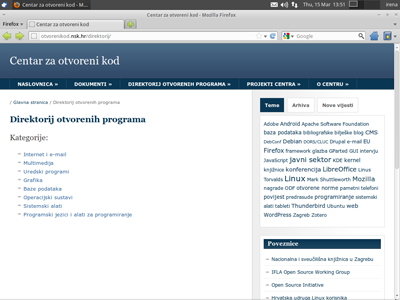 knowledge base which would provide all the relevant information
in this field and enable the downloading of specific software. Thus the
principal task of the Directory is to assist libraries and their users in
finding useful open source applications. At the same time, this knowledge base
serves as an effective support in other Center’s projects.
knowledge base which would provide all the relevant information
in this field and enable the downloading of specific software. Thus the
principal task of the Directory is to assist libraries and their users in
finding useful open source applications. At the same time, this knowledge base
serves as an effective support in other Center’s projects.
Software packages included in the Directory are classified by their purpose and organized in eight categories. Currently the Directory contains some one hundred programs, and the plans envisage the adding of new software packages along with providing detailed descriptions. Pages of individual applications provide links to installation packages and their source code.
A Regional Strategy for an Arab Digital Content Industry
 Dr. Ramy Abboud
Dr. Ramy Abboud
Lecturer in the Library and Information Science Department, Menofia University,
Egypt
Government sectors in the Arab World recognized the importance of being part of the current Information Society during the nineties. This recognition was translated into several local and regional policies or strategies that have pushed digital infrastructure closer to global standards and international competitors. However, unlike the case of digital infrastructure, these past efforts did not result in tangible achievements in terms of digital content that would successfully put the Arab Digital Content Industry (ADCI) in a competitive position in terms of global content.
The current revolutions sweeping through key Arab nations, referred to as the “ Arab Spring” in the global media, highlighted the crucial importance and role of the digital content in creating change in this part of the world and even globally. Previous development in the ICT infrastructure supports the freedom of dissemination and access to information amongst young Arabs that lead local societies toward a better level of digital awareness.
Although the Arab World hosted the first World Summit on Information Society (WSIS) in Tunis in 2005 and given the population size of the Arab nation of more than 300 million, the size of the Arabic Digital Content compared to the global content is very low. Despite the lack of accurate indicators to measure the size of the Arabic digital content, it is roughly estimated to lie between 2.5% and 3% at the most. The main reason behind this low size of Arab digital content was the inexistence of an integrated strategy that takes into consideration the regional dimension of the ADCI through collaborative and efficient efforts; a strategy that distributes resources equally, and realizes the high importance of digital content in supporting and promoting sustainable development. A strategy that supports an active role of Arab states in the global knowledge society, and highlights the Arab Identity in the current globalization. Such a strategy should also adopt unconventional solutions instead of replicating foreign practices without taking into consideration the local conditions on the ground.
Hence, the focus of this study - entitled: Towards an Arab Strategy for Digital Content Industry : A Comparative Study - was to establish a regional strategy prototype model for the ADCI, one that seeks the maximum level of accuracy and integration taking into consideration previous strategic-planning efforts, available resources and the best methodological/scientific practices. This strategy model can be introduced to the Arab Governments for further enhancement and adoption, along with proposed solutions to come over the expected implementation hurdles.
This paper consisted of a comparative analysis of the national policies in relation to digital content conducted across eleven Arab and Non-Arab countries divided into two groups: 1- Arab Group, including: Morocco, Egypt, Jordan, Palestine, Lebanon, Syria and Saudi Arabia 2- Global Group, including: Brazil, European Union, South Africa and Japan. This comparative study, followed by a SWOT analysis of the ADCI, were aimed at extracting constructive components that were inherited into the proposed Strategy Model. Consequently, by the end of this process, we were able to detect a number of opportunities to benefit from during the structuring process of the Prototype Regional Strategy Model which was called “e-Arab”.
Consequently, the vision of “e-Arab” was to establish an Arab competitive digital-content industry, being itself a major regional project that is expected to receive contribution from the Arab governments and different stakeholders, in order to: enhance Arab nations’ contribution in the global knowledge economy, help in achieving a regional sustainable development, improve both the life style and the work style and highlight the Arab identity.
“e-Arab” has taken into consideration the fact that the Arab governmental cooperative projects have proven not to be as successful as expected, due to many reasons especially bureaucracy. The strategy model was based on various aspects that are believed to help overcome many similar hurdles, such as but not limited to: adopting creative solutions; adopting decentralization trends during the implementation process; applying and promoting creativity and innovation within the body of the local society; emphasizing the role of the civil society especially in monitoring and redirecting the operational performance; enhancing the level of contribution of various stakeholders such as the private sector, the community, banks, donors, regional institutions and international organizations; Raising the local awareness of the strategic targets of the ADCI; Supporting Small and Medium Entities (SMEs) as well as Micro-entities; building applications that mainly focus on the local needs; ensuring flexibility in the structure of the strategy model and focusing only on three major sectors considered as the highly prospective ones: e-learning, e-culture and e-entertainment.
The action plan of the strategy model consists of 203 initiatives that were categorized into 23 strategic targets which were then grouped into three main pillars. However, the overall action plan was based on two major initiatives that are expected to genuinely support the strategic vision of e-Arab. These two major initiatives are as follows: 1- establishing the Arab Digital Cross-Corridor (ADCC) as a regional mega project (see Fig. below), 2- establishing the Arab Council for Digital Content (ACDC) as an active regional governance body.

Fig. (1) the Arab World Map according to the initiative of the Arab Digital Corridor.
In order to make the best of the available resources of the strategy and the proposed time frame of the implementation, all initiatives were prioritized according to a matrix that measured the relation between each single initiative on one side and all strategic targets on the other side. Accordingly, the e-Arab initiatives were divided into two main categories: 1- pre-requisite initiatives, 2- initiatives prioritized according to impact into three sub-categories: low, medium and high impact initiatives.
The initial version of “e-Arab” was reviewed and modified by a small structured group of Experts called “e-Group A” in order to come up with the final version. The “e-Group A” comprised representatives from various institutions, such as but not limited to: the Arab League, Cairo University, University of Wisconsin – Milwaukee.
Consequently, the final version of “e-Arab” model was passed on in turn to another wider structured group of Experts called “e-Group B” where we worked closely through Delphi Method with representatives of some Local, Regional and International entities such as but not limited to; the ICT Ministries of both Egypt and Jordan, UN Economic & Social Commission for Western Asia (UN-ESCWA), Harvard University, Private digital-content companies … etc.
During three Rounds of Delphi, we managed to measure the components of “e-Arab” qualitatively and quantitatively and to reach consensus accordingly. The Delphi study helped also in identifying the major opportunities and implementation risks of “e-Arab”, in addition to proposing solutions that mostly represents the views of the Delphi Experts.
We hope that this “e-Arab” Strategy Model will attract attention of the decision makers in the Arab World in order to be implemented either on a regional scale or on a semi-regional scale, taking into consideration necessary actions and amendments in respect to the original model. Also, we hope that the local Arab Governments can benefit from the components of the “e-Arab” and particularly the strategic initiatives that can also be applied on a local scale.
However, we strongly believe that the key issues behind any success in the ADCI are mainly: the awareness of both public and decision makers of local Governments and the improvement in the level of innovation and creativity in the local society. Also, establishing a competitive ADCI is subject to the local support that is given to the SMEs and to an effective monitoring by the public to the governmental relevant efforts. Generally speaking, the ADCI possesses a great potential in the future, given the strength and diversity of the demography of the Arab World, in addition to the large Arab heritage.
Finally, the responsibility of establishing a competitive ADCI and a regional knowledge-based economy should not only be given to the governments but also to the public given that people play an integral role in developing digital content and are an efficient element in the digital world.
Using a LibGuide to Track and Deliver Mobile Access”
 Rochelle Ballard
Rochelle Ballard
Digital Resources Coordinator, Princeton University
As the Digital Resources Coordinator at Princeton University, my primary responsibility is the management of electronic resources. A major aspect of the job is ensuring access to all electronic content. Generally, accessing library materials is an on campus, off campus scenario. Licensed or purchased electronic resources are available to authorized users from any physical location and to on-site users of the University’s library and campus computer networks. The proliferation of mobile devices adds a new wrinkle to this old scenario. In addition to being concerned about access to library resources from any place at any time, we must now think about accessing them from any device.
I initially thought that providing mobile access to library resources simply entailed identifying vendors with mobile optimized websites and listing the appropriate URLs. I quickly realized that this was not the case. The modes and methods of delivering mobile access are as varied as the many devices capable of accessing them. Before establishing mobile access to the library’s resources, I had to learn more about these methods and become mobile access literate.
Concerns
When considering mobile access, I had a few questions and concerns that needed to be answered and addressed. I was primarily concerned with the following issues:
- Identifying the vendors and resources that were mobile accessible.
- Authenticating access to library resources via mobile devices.
- Testing access.
As the administrator of the library’s electronic resources subscriptions, I receive vendor updates and newsletters. Many resources can be accessed via mobile devices. However, some vendors have made a concerted effort to create mobile optimized websites or develop mobile apps that enhance access via mobile devices. I started a file of email notices and vendor correspondence relating to mobile access. Additionally, I looked at pages designed by other libraries and noted the vendors/resources they listed. After compiling a list of the vendors providing mobile access to their products, I investigated how access was delivered and started documenting detailed instructions for initiating access.
Vendors deliver mobile access in a variety of ways. Many have designed smart websites that automatically detect the type of device being used and redirect users to the appropriate web interface. Generally, the mobile site is a stripped down, bare bones version of the primary website. Images and special features are stripped away allowing the mobile website to load quickly and display on smaller screens. Additionally, some vendors will provide a direct mobile URL or an app to control access.
Authentication was a key concern and is essential in connecting authorized users to library resources. Users on campus can tap into the campus wireless network. However, it is my assumption that many users will probably be off campus. At Princeton University, remote access is authenticated via the library’s proxy server, the University’s Virtual Private Network (VPN) or Shibboleth. In my quest to become mobile access literate, I discovered additional methods for authenticating access. Device pairing associates the end user’s mobile device with the library’s subscriptions. It generally requires the creation of a user account and activation periods vary from as short as 48 hours to as long as a year. Once the period ends, the user must re-pair the device. Additionally, some vendors allow mobile access via user accounts established onsite with no additional authentication. In a few cases, I found authentication required an institutional password or subscription ID.
Testing mobile access can be a challenge. Most of us own at least one mobile device. However, I wanted to test access on a variety of devices. A couple of years ago, the library created a “Technology Sandbox”. An assortment of mobile devices including tablets, Kindles and Nooks were purchased for staff use. These devices coupled with my iPad and iPod provided a suitable testing ground and the opportunity to configure and access resources on a variety of mobile devices.
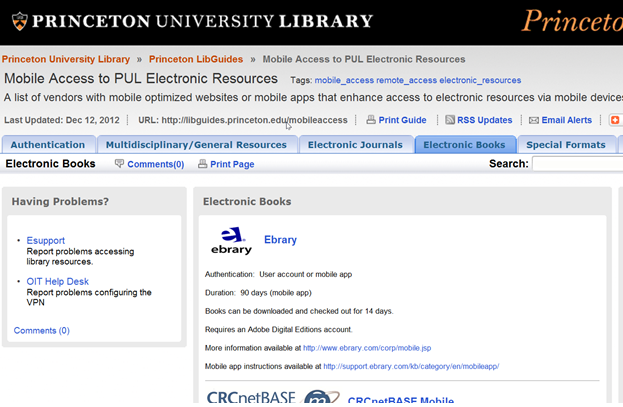
Why a LibGuide?
To adequately document mobile access to library resources, I needed to create an easily accessible management tool listing the vendors/resources and pertinent information concerning mobile access. I started noting the availability of mobile access and storing the mobile URL in Meridian, our electronic resources management system (ERMS). I also created a document containing step-by-step instructions for establishing mobile access to the various resources. Our ERMS is restricted to library staff and rarely used. Additionally, the detailed document I created was another information silo inaccessible to others. I needed a readily available method to store and share this information with colleagues and end-users. Because it is easily maintained and accessible to others, a libguide seemed the perfect tool to satisfy both needs.
Currently, we maintain separate A-Z lists for databases and electronic journals. I did not want to duplicate these lists. Mobile access is primarily vendor driven so I decided to organize the libguide by resource type and vendor. The front page defines the different methods of authentication. Additional pages list mobile access instructions for multidisciplinary/general electronic resources, electronic journals, electronic books and special formats (image, music, and video) and are arranged by vendor.
Each entry provides the mobile URL, method of authentication and a link to mobile access instructions on the vendor website. Additionally, a tab for usage statistics lists vendors who provide statistics on the number of accesses via mobile devices. The complete guide is available at http://libguides.princeton.edu/mobileaccess.
What’s Next?
The Mobile Access Lib-Guide is a work in progress and is updated as vendors add and change mobile access to their resources. I have also added mobile access to my checklist of questions for vendors when subscribing or purchasing new electronic content. Take a look and let me know what you think. Rochelle Ballard, rballard@princeton.edu
National Parliament Of Solomon Islands Digital Library System
 Boniface Supa
Boniface Supa
Senior Librarian, National Parliament Of Solomon Islands
The National Parliament of Solomon Islands Library has made the most
noticeable progress during 2012 with the introduction of a digital library
capturing the parliamentary record and digital publications by and about the
National Parliament. This is the result of a review 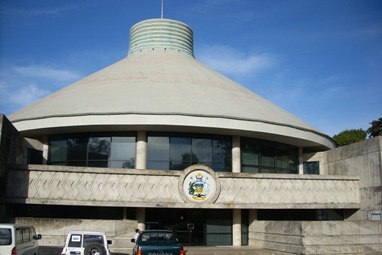 from 24th – 28th October
2011 facilitated by NSW Parliamentary Library staff member Deborah Brown,
Manager, Reference and Information Services. One of the significant
recommendations on the review was to introduce a digital repository for the
National Parliamentary Library.
from 24th – 28th October
2011 facilitated by NSW Parliamentary Library staff member Deborah Brown,
Manager, Reference and Information Services. One of the significant
recommendations on the review was to introduce a digital repository for the
National Parliamentary Library.
National Parliament of Solomon Islands Library has strong aspiration for the creation of Digital Library, which one of the prioritized recommendations. The execution of the activities involved includes wide consultations for a proposed open source solution and the formation of library team faciliteated this process. The working team chose a vendor to assist with the onsite open source implementat (Prosentient System Limited) while manging the systems through their own technical support team.
Getting the project on the ground, National Parliament of Solomon Islands and Prosentient System developed strategic plans for site visit and configuration workshop, which was achieved on March 2012. On April 24th 2012, Dr. Edmund Balnaves made the second visit and established the implementation of the DSpace for National Parliament and import of existing documents. The site was launched for "go live" on the 20th April 2012. The drive towards the project was very aspired and significantly achieved within the duration of one month, as from 27th March – 20th April 2012.
At the launch event, the Speaker of the National Parliament of Solomon Islands, acknowledged the work of the library team and Dr Balnaves to achieves a significant success in the wide range of digital records that the Parliament could now make available to its Members and Staff.
Senior Librarian, Boniface Supa and Library Assistant Ray Sibisopere have taken on roles in managing the open source syste, and by administering and training the users in utilizing the digital repository.
Book Reviews
 Building Mobile
Library Applications. Jason A Clark
Building Mobile
Library Applications. Jason A Clark
London: Facet, 2012. ISBN 9781856048453.
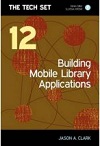
 Libraries that are about
to launch into buildng their first mobile app should be prepared for a rocky
ride. The number one gripe of app developers is the diversity of platforms that
have to be covered, each with their own development language, different methods
for app delivery and different criteria for app acceptance. Clark's
introduction to mobile app development provides a good set of guidelines for
the different methods for delivering content to the mobile device, through
website styling and, web app and full app development. The book looks at both
the broader project processes around building apps and the specifics of app
development for iPhone and Android (the new windows platform postdating the
publication of the book). Parts of the book are technical, delving into the app
development process with illustrations based around reusing code from existing
projects. It is well worth the librarian understanding and engaging in the
technical issues (and frustractions) around the app development, as this
understanding will help frame choice of methodology within a given library
context (whether to go with an app-styling for the website or a true app).
Libraries that are about
to launch into buildng their first mobile app should be prepared for a rocky
ride. The number one gripe of app developers is the diversity of platforms that
have to be covered, each with their own development language, different methods
for app delivery and different criteria for app acceptance. Clark's
introduction to mobile app development provides a good set of guidelines for
the different methods for delivering content to the mobile device, through
website styling and, web app and full app development. The book looks at both
the broader project processes around building apps and the specifics of app
development for iPhone and Android (the new windows platform postdating the
publication of the book). Parts of the book are technical, delving into the app
development process with illustrations based around reusing code from existing
projects. It is well worth the librarian understanding and engaging in the
technical issues (and frustractions) around the app development, as this
understanding will help frame choice of methodology within a given library
context (whether to go with an app-styling for the website or a true app).
This book is a useful addition to the wider discussion of development of mobile apps. There is a universe of functions possible at the app layer that this book can only touch on, but blogs such as m-libraries (http://www.libsuccess.org/index.php?title=M-Libraries) are useful additions to this understanding.
 The e-copyright
handbook
The e-copyright
handbook
by Paul Pedley
London: Facet, 2012. ISBN 9781856048279.
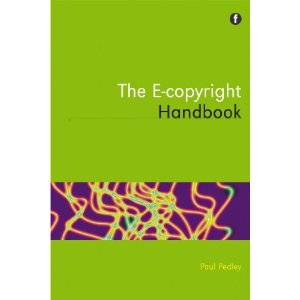
"It is all very well having strict copyright laws in place, but if they are amongst the most broken laws on the plant, or if it is simply too costly and too time-consuming for a rights owner to take action through the courts... one has to question the effectiveness of the legislation regime for protecting copyrights" (p.140). This is the despondent comment from Paul Pedley on copyright enforcement, and it sums up the bleak picture painted on the e-copyright sphere. This book provides a useful survey of the electronic copyright scene, and the cross-over from copyright to licensing. It is difficult for a book such as this to provide a conclusive picture given the state of flux in this area. Nevertheless it is impossible to avoid an understanding, given librarians sit astride the whole copyright arena. Libraries providing interlibrary loans, lending e-books and digitising resources have to address complex questions in the process, and a core ethical responsibility of the librarian is to understand and work within the responsible use of intellectual property while also encouraging the free flow of information. Unlike the better organised "Essential law for information professionals" this work is a little repetitive and piecemeal in its organisation. However the level of detail is good and the illustrations of cases useful.
 Cloud computing
for libraries
Cloud computing
for libraries 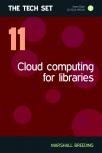
by Marshall Breeding
London: Facet, 2012. ISBN 9781856048477.
Marshal Breeding touches on the tension between internal IT services and libraries. These tensions are a significant driver for libraries to seek external management of their services. If, as Breeding suggests, the move to cloud computing may change the staff mix, with a move a way from the more technical internal support capabilities, then this would be disappointing. The possibilities emerging for libraries out of open source can entail greater agency and ownership relating to the systems managed by the library. A good blend to enable technical engagement without low-level technical burden may be the blend of cloud hosting with open source. Breeding points to this in the example of DuraCloud for dspace digital library hosting. This is a good technical introduction to those who want to "wrap their head" around this new dimension for library service provision.
Reviewed by Edmund Balnaves, Information Officer, IFLA IT Section
About the Section
The Information Technology Section (ITS) serves to promote and advance the application of information technologies (IT) to library and information services in all societies, through activities related to standards, education and training, research, and the marketplace. At present, the IT Section has 24 standing committee members from 23 different countries.
The section meets every year at the IFLA annual Congress. In between
congress sessions, section members collaborate with other Sections in progress
and workshops. The section maintains a micro-site within the IFLA website at http://www.ifla.org/it. This site has news,
blogs and resources regarding activities of the Section, as well as session
minutes, publications and section membership details.
There are ballots for elections every two years, as members complete their
terms of four years. See the complete list of SC member at the end of this
newsletter. The IT Section is the second biggest section in IFLA with over 370
members from 90 countries and all types of libraries. The section members come
from a range of disciplines, and the section itself is strongly involved with
the activities of other IFLA sections. If you would like to join our section,
please contact IFLA Headquarters or consult the IFLA membership information at:
http://www.ifla.org/en/membership.
The section also maintains a listserv. The purpose of the IFLA-IT mailing
list is to provide a forum for the members of the Section on Information
Technology to exchange ideas and experience in use of information and
communication technologies in libraries. To subscribe please go to the web
interface at http://infoserv.inist.fr/wwsympa.fcgi/info/ifla-it.
Primary contacts
Chair
Alenka Kavčič-Čolić, National & University Library, Slovenia, Alenka.Kavcic@nuk.uni-lj.si
Secretary
Frank Cervone, Purdue University Calumet
fcervone@purduecal.edu
Information Coordinator
Edmund Balnaves, Prosentient Systems, Australia
ejb@prosentient.com.au
Standing Committee Members 2009-2013
Emmanuelle Bermes Chef de projet Multimédia - Centre
Pompidou France Emmanuelle.bermes @centrepompidou.fr
Alenka Kavčič-Čolić National & University Library
Slovenia Alenka.Kavcic@nuk.uni-lj.si
Giuliana de Francesco ICCU - Instituto Centrale Catalogo Unico
Delle Biblioteche Italiane Italy defrancesco@beniculturali.it
Vivekanand Jain Banaras Hindu University India
vivek-digora@rediffmail.com
Lesiba Steve Ledwaba National Library of South Africa Sth
Africa lesiba.ledwaba@nlsa.ac.za
Andrea Marchitelli CILEA Italy marchitelli@cilea.it
Penny Robertson Scottish Library and Information Council UK
scotearl@slainte.org.uk
Sue Stimpson, Library of Parliament, Canada Canada
stimps@parl.gc.ca
Hilde van Wijngaarden, Koninklijke Bibliotheek Netherlands
hilde.vanwijngaarden@kb.nl
Zhixiong Zhang, Library of Chinese Academy of Sciences China
zhangzx@mail.las.ac.cn
Standing Committee Members 2011-2015
Edmund Balnaves Prosentient Systems Australia
ejb@prosentient.com.au
José Luis Bueren Gómez-Acebo Biblioteca Nacional de España
Spain joseluis.bueren@bne.es
Frank Cervone Perdue University Calumet United States
fcervone@cervone.com
Mikhail Goncharov Russian National Public Library for Science and
Technology Russian Federation goncharov@gpntb.ru
Nina Hyvönen The National Library of Finland Finland
nina.hyvonen@helsinki.fi
Annika Lund The Jakobstad City Library Finland
annika.lund@jakobstad.fi
Shawky Salem ACML-Egypt Egypt chairman@acml-egypt.com
Lars G. Svensson Deutsche Nationalbibliothek Germany
l.svensson@dnb.de
Dawei Wei, The National Library of China China
weidw@nlc.gov.cn
Corresponding Members
Antonin Benoit Diouf, Université Gaston Berger Senegal
antoninbenoit@gmail.com
Tiina Ison, National Library of Finland Finland
tiina.ison@helsinki.fi
Alexeis Garcia Pérez, Cranfield University UK
alexeis.garcia-perez@coventry.ac.uk
About the contributors
Ramy Abboud, PhD
Dr. Ramy Abboud, holds BA, MA and Ph. D. in Information Science. He was awarded the Prize of the Arab Federation for Libraries and Information AFLI for the Best Academic Study of the Year, 2012 . His Ph. D. thesis was mainly to create a detailed strategy model that focuses on the Arab digital Content Industry. Dr. Abboud is currently a Lecturer in the Library and Information Science Department, Menofia University, Egypt, in addition to being a consultant in the field of digital publishing and Arab digital content. Dr. Abboud ihas a number of books and peer-reviewed papers within the field of Information Science, digital content and related areas, including the first complete Reference in the Arab World on “E-Books” (2008). ramyaboud@yahoo.com
Edmund Balnaves, PhD
Edmund Balnaves is the Information Officer for the Information Technology Section of IFLA, is a Director of ALIA and unashamedly dabbles with library information technology in his company Prosentient Systems
Simon Ball
Simon started work as EIFL-FOSS Programme Manager in July 2010. He comes to EIFL with a decade of experience in enhancing access to education through technology in the UK, working for JISC TechDis. His work to date has encompassed a wide range of themes, from the use of Free and Open Source Software to aid users’ access to computer-based information, to the development of an Open Source e-portfolio system for students with learning disabilities, and the creation of a free online self-assessment tool for accessibility in universities. He is keen to extend the work of the FOSS program to date, utilizing new and different technologies to maximize the impact of FOSS in enhancing access to knowledge.
Anonin Benoit
Anonin is the Head of Library & Documentation Division at the United Nations African Institute for Economic development and Planning (IDEP) in Dakar, SENEGAL. He is a corresponding member of the IT section and strongly involved in the promotion of Free and Open source systems for libraries in Senegal, through the EIFL-FOSS program which collaborate closely with the Senegalese academic Libraries Consortium. He is also involved in the sector of Digital libraries in Africa as a member of the African Digital Library Support network (ADLSN). More details of his professional involvement can be read in his librarian blog: http://antoninbenoitdiouf.com.
Alenka Kavčič-Čolić, PhD
Alenka is the chair of the IFLA Information Technology Section and the Head of Library Research Centre at National and University Library. She has presented in and organised many sessions and conference in the area of digitisation, semantic web and digital libraries.
Petteri Kivimäki, BSc
Petteri, is an Information Systems Specialist at The National Library of Finland. He has graduated from software engineering and has been working in customer service in libraries since 2000 and in library information technology since 2004.
Boniface Supa
Boniface Supa is the Senior Librarian at the National Parliament of the Solomon Islands. He is responsible for the library collection (managed in Koha) and the digital library (managed in DSpace) representing the parliamentary record of the naitonal Parliament.
Irena Petrijevčanin Vuksanović
Irena works at the Center for Open Source in Croatia (http://otvorenikod.nsk.hr). Her current focus is open source Content Management for ibraries. ivuksanovic@nsk.hr
PDF Version
The PDF version of this newsletter is available at: http://www.ifla.org/files/assets/information-technology/tilt_v1_i2.pdf


